Having previously looked into my grandfather Frederick’s paternal ancestors the Englands, in this new series of posts I will attempt to trace the history of his mother’s family, the Lings. This first part focuses on their origins in the village of Hundon and tracks their progress through the centuries up to the late 1850s.
* * *
Although the medieval origins of the name ‘Ling’ hint at an even more ancient family connection to East Anglia, the earliest known ancestors of my grandfather Frederick England’s mother Maud can be traced back to a small collection of villages in Seventeenth Century Suffolk. The first of these whose names we know were Maud’s seven-times great-grandparents Abraham and Mary Linge, whose five children were all baptised in Hundon between 1665 and 1676. Given their children’s baptism dates, it seems likely Abraham and Mary would have been born in the 1640s at the height of the Civil War. This chaotic backdrop may explain why no baptism record can be found for either of them, as in many villages a breakdown in civil society combined with the religious upheavals of the time led to an extended gap in parish registration. According to Leonard Caton:
During the disquiet which led to the Civil War William Dowsing, who was born in Laxfield in Suffolk , came to [Hundon’s] All Saints Church in 1643 and his Puritanical beliefs led him and others to destroy 30 pictures and take down three popish inscriptions there as well as ordering the steps to be levelled. He did similar damage in over 150 Suffolk churches where he smashed stained glass windows, brasses or anything that he thought had Roman Catholic overtones.
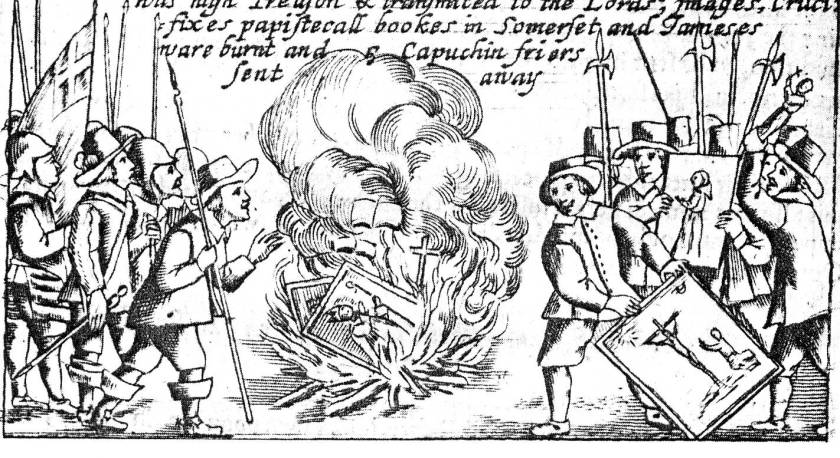
Little is known of Abraham and Mary’s lives during and after the Civil War, however an ‘Abram Longe’ is recorded in the Hundon Hearth tax returns of 1674 whose house apparently contained two fireplaces. In addition there is an inventory of goods belonging to John Pritches of Hundon in Suffolk Record Office (Ref. HD 1538/266/3) which was co-written by Abraham on 14 October 1681. Abraham died and was buried in Hundon on 22 July 1715, three years after the burial of a ‘Mary Ling,’ who may have been his wife, on 13 February 1712. While Abraham and Mary had grown up during arguably the most turbulent period in British history, by contrast their son Richard Linge (bp. 12 July 1674) and the majority of his descendants would probably have led far more tranquil lives working as thatchers, millers or agricultural labourers tilling their quiet corner of eastern England.
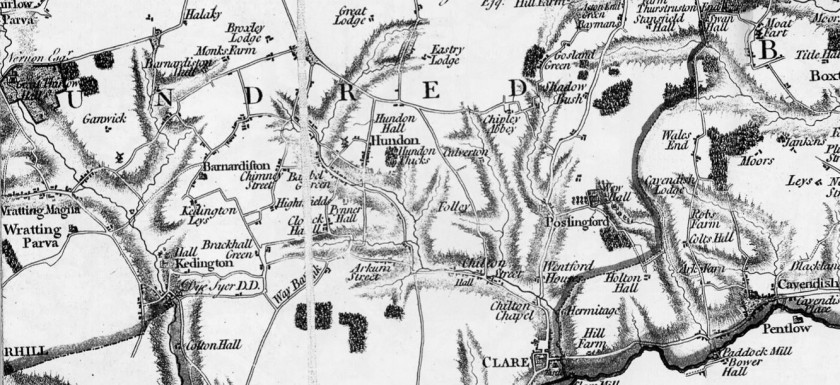
Richard and his wife Susan Linge appear to have had five children between 1695 and 1706, the eldest of whom, Thomas, was Maud Ling’s five-times great grandfather and the first in a line of four direct ancestors of hers to bear that name. Their details, as well as those of their wives, were as follows:
- Thomas Ling (b. c. 1695, Hundon, Suffolk) and Mary Gilbert (bp. 9 May 1698, Hundon, Suffolk, m. 11 August, Hundon Suffolk)
- Thomas Ling (bp. 20 March 1725, Hundon, Suffolk) and Grace Summers (bp. 18 January 1718, Hundon, Suffolk, m. 25 October 1748, Hundon, Suffolk)
- Thomas Ling (bp. 4 December 1749, Hundon, Suffolk) and Ann Firman (b. c. 1750, m. 5 November 1772, Hundon, Suffolk)
- Thomas Ling (b. c. 1776, Hundon, Suffolk, bp. 16 July 1780, Hundon, Suffolk – d. 1 May 1862, Hundon, Suffolk) and Mary Cuthmer (b. c. 1769, Poslingford, Suffolk, m. c. 1804 – d. c. 1856, Suffolk)
The fourth Thomas Ling listed above is the first for whom we have anything other than parish registers to rely on for biographical information. In the 1841 census he is listed as an agricultural labourer, however by 1851 both he and Mary were said to be paupers (i.e. supported through parish poor relief, the closest the Nineteenth century had to a welfare system) and had moved in with their son Joseph’s family on Clare Road. Mary appears to have died at some point the following decade, as by the time of the next census in 1861, Thomas, now eighty four, is the only one of Joseph’s parents still living with him. He died on 1 May the following year and was buried in the village churchyard. Between them he and Mary had had at least five children, whose names were:
- Susan (bp. 5 April 1806, Poslingford, Suffolk – d. 21 May 1859, Hundon, Suffolk)
- Thomas (b. abt 1809, Hundon, Suffolk – 24 September 1864, Toodyay, Western Australia)
- Sophia (b. 5 April 1810, Hundon, Suffolk)
- Sarah (b. 8 November 1812, Hundon, Suffolk)
- Joseph (b. abt 1818, Poslingford, Suffolk)
Both Thomas Jr. and Joseph became agricultural labourers, although at the time of the 1841 census Joseph had been as a blacksmith. Thomas Jr. appears to have been in trouble with the law on numerous occasions, the first of which occurred in 1830 when he was sentenced to three months imprisonment for stealing “a quantity of potatoes, the property of David Potter” (The Ipswich Journal, 27 March 1830, p. 4, col. 5). Three years later he was imprisoned again for two months for stealing part of an elm tree (The Suffolk Chronicle; or Weekly General Advertiser & County Express, 5 October 1833, p. 4, col. 6), and in December 1844 he was arrested for night poaching, fittingly enough, in a place named ‘Ling Wood’ near Stoke with three other men (The Norfolk News, Eastern Counties Journal, and Norwich, Yarmouth, and Lynn Commercial Gazette, 5 April 1845, p. 4, col. 4). Although poaching was a widespread and even tacitly accepted means of supplementing the wages of rural labourers, the punishments inflicted were often harsh. After pleading guilty on 27 March the following year Thomas was sentenced to two months’ imprisonment and hard labour at Bury Gaol.
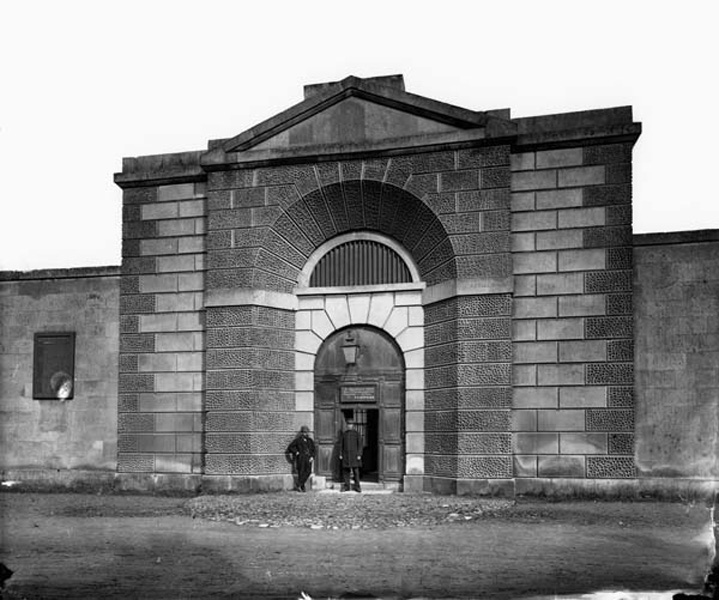
It would be ten years before Thomas received his final and most serious conviction, when on 2 July 1855 he was sentenced to fourteen years’ transportation for sheep stealing (The Suffolk Chronicle; or Weekly General Advertiser & County Express, 14 July 1855, p. 4. col. 1), a crime which still carried the death penalty in certain cases. He set sail from London aboard the convict ship Clara on 19 March 1857, and arrived one hundred and six days later in Fremantle, the main port of Australia’s Swan River Penal Colony. According to his entry in the Convict Transportation Registers, Thomas had been 5’2″, dark and stout with brown hair and hazel eyes, semi-literate, a Protestant, and a father of five. He also was also recorded as having a number of tattoos, including a mermaid on his right arm, a cross and a ring on his right hand, plus a dog and hare and two birds on his left arm (Steve Smith, e-mail message to author, 11 September, 2016). Five years after his arrival he received a conditional pardon on 15 Decemeber 1862, but he would never return to England. He died just two years later.
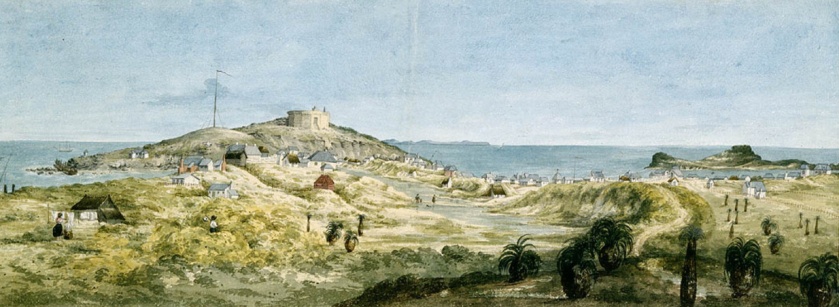
While it is unclear what happened to either Sophia or Sarah Ling, we know rather more about their eldest sister Susan, Maud Ling’s great-grandmother. In 1824, when Susan was eighteen, she was described as a pauper in the Hundon parish registers. As she is not recorded as suffering from any form of physical disability (e.g. blindness) in later census returns, to qualify for parish support at such a young age means her family must have been either unable or unwilling to help her financially. Given that her parents were themselves listed as paupers in the 1851 census it’s clear her family were far from wealthy, so the former is certainly possible. The latter scenario is perhaps equally plausible however, as the reason for her appearance in the parish registers of 1824 was because that year she gave birth to an illegitimate son, George Ling, who was baptised on 19 September. Taking into account the prevailing attitudes towards illegitimacy at the time we cannot rule out the possibility that she may have been disowned by her parents after becoming pregnant.
As was usually the case in these circumstances, the father’s name was not mentioned on George’s baptism record, however later events may provide a clue to his identity. Just a few months after George’s baptism, Susan married an agricultural labourer named Samuel Mayes on 7 January 1825. The closeness of this date to George’s baptism, plus Samuel’s apparent willingness to marry this young, presumably ‘disgraced’ single-mother, could be an indication that Susan was involved in an affair with him at the time George was born, or perhaps that he was pressured into the marriage by Susan’s parents. They had at least two sons in the decade after their marriage, John (bp. 17 May 1829, Keddington, Suffolk) and Thomas (bp. 12 August 1832, Keddington, Suffolk – d. abt November 1904, Alfreton, Derbyshire), however Samuel appears to have died at some point before the 1841 census, leaving Susan once again with no family support and in receipt of parish pay.
At around forty nine years of age Susan is said to have contracted scrofula (Bury and Norwich Post, and Suffolk Herald, 3 May 1859, p. [2], col. 7), a disease usually caused by tuberculosis whose most noticeable symptoms are the development of chronic abscesses on the neck. In centuries past it had been known by the name the ‘King’s Evil,’ for it was believed only a royal touch could cure it. After apparently “suffering dreadfully” from the disease for four years she died at her home in Hundon on 21 May 1859 aged fifty three, although it’s not clear whether this was as a direct result of her condition. The sad details of her final hours can be found in the coroner’s inquest report below which was printed in the Bury and Norwich Post the following week.
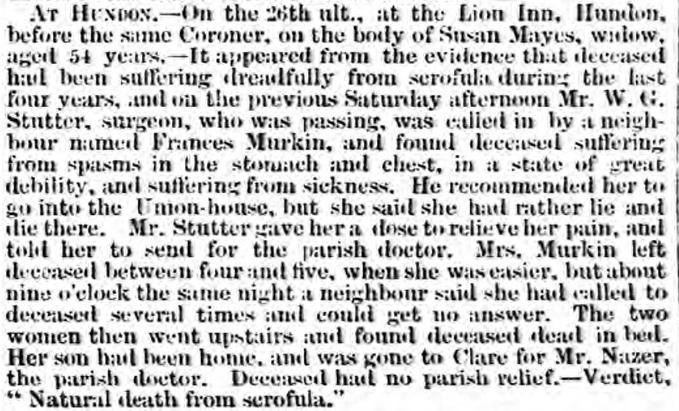
Susan’s youngest sons John and Thomas Mayes, both of whom she had been living with at Horn Row in 1851, went on to become agricultural labourers like their father Samuel. Her eldest son George however had already left Suffolk by 1851, and was beginning to set in motion the unlikely chain of events which would cause the Ling family name to become synonymous with travelling within just two generations. His story continues in the next post, where we’ll find him living in Barnsley with his wife Elizabeth and infant son John, Frederick England’s grandfather, in 1849.
Sources
Caton, L. ” A Brief History of Hundon”. The Village of Hundon, Sudbury, Suffolk. December 2007. Accessed 11 March, 2016. http://www.hundon-village.co.uk/hundonhistory.html.
Evans, George Ewart. Ask the Fellows Who Cut the Hay. London: Faber and Faber, 1965.

Goodness. Poor Susan certainly seems to have had more than her fair share of suffering. Here in Ripon we have a Workhouse Museum,(http://riponmuseums.co.uk/museums/workhouse_museum_gardens/) which also makes plain that having an illegitimate child is a sin for which young mothers (but not young fathers) paid a heavy price.
LikeLike
It doesn’t sound like the easiest of lives does it? Hopefully she enjoyed some happier times in between the hardships she must also have endured.
Thanks for the link, I’ll try and arrange to visit when I’m next up that way!
LikeLiked by 1 person
Let me know if you do find yourself up here.
LikeLike
Hi Rob I think I did contact you a long while ago as I am also a descendant if Abraham a d Mary but further down the generations I descend from Thomas b1725 and his first wife Mary who had a son John in 1740 but she then died 4 years later and he married Grace Summers.
Have you any idea how long the Lings had been in Hundon.
I have a map that shows that in the 1800s Suffolk was heavily populated with Lings and wondered if they may have come from Denmark or thereabouts as that would have been the nearest landing place.
Best wishes. Jenny Stroud nee Ling.
LikeLike